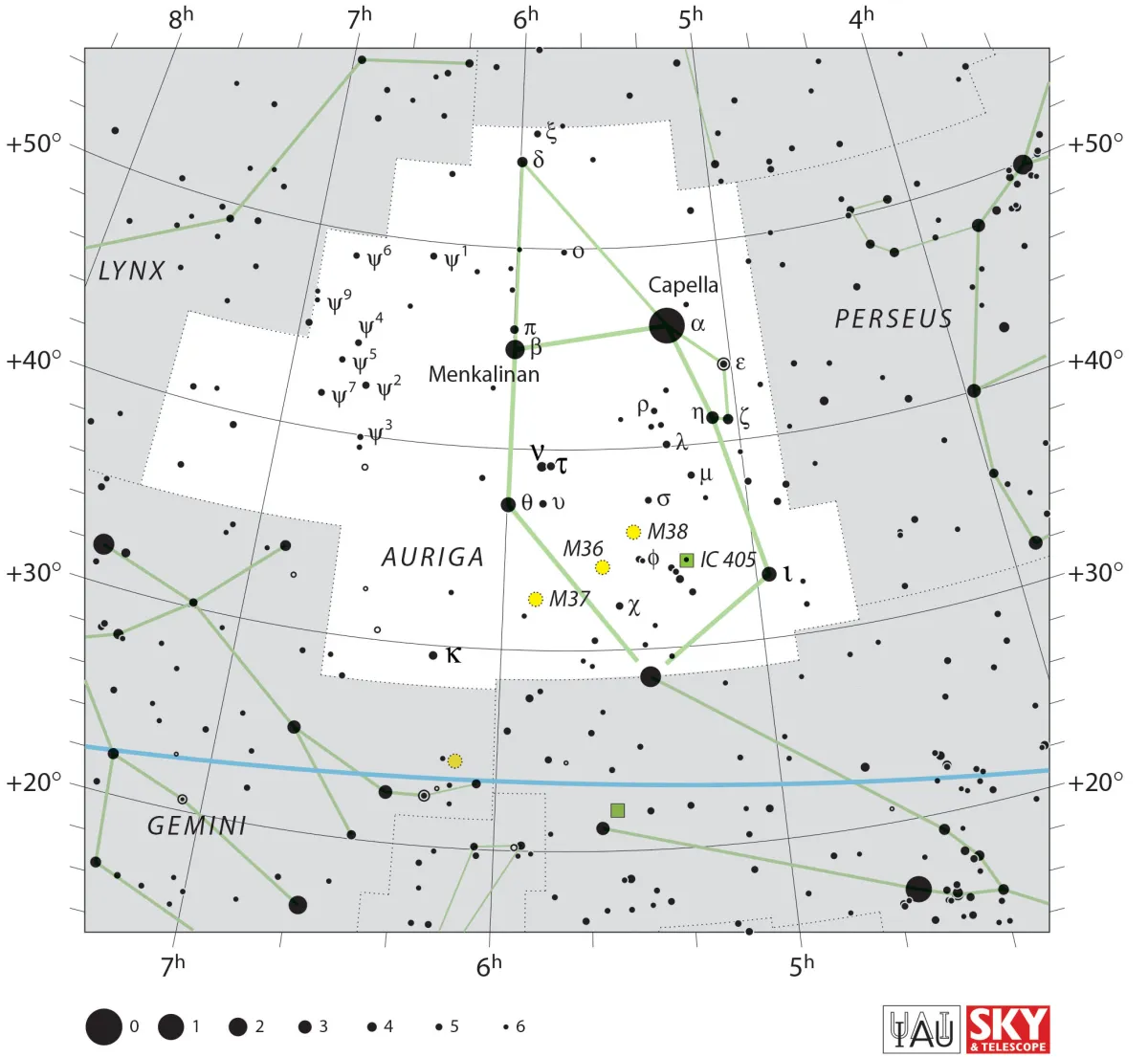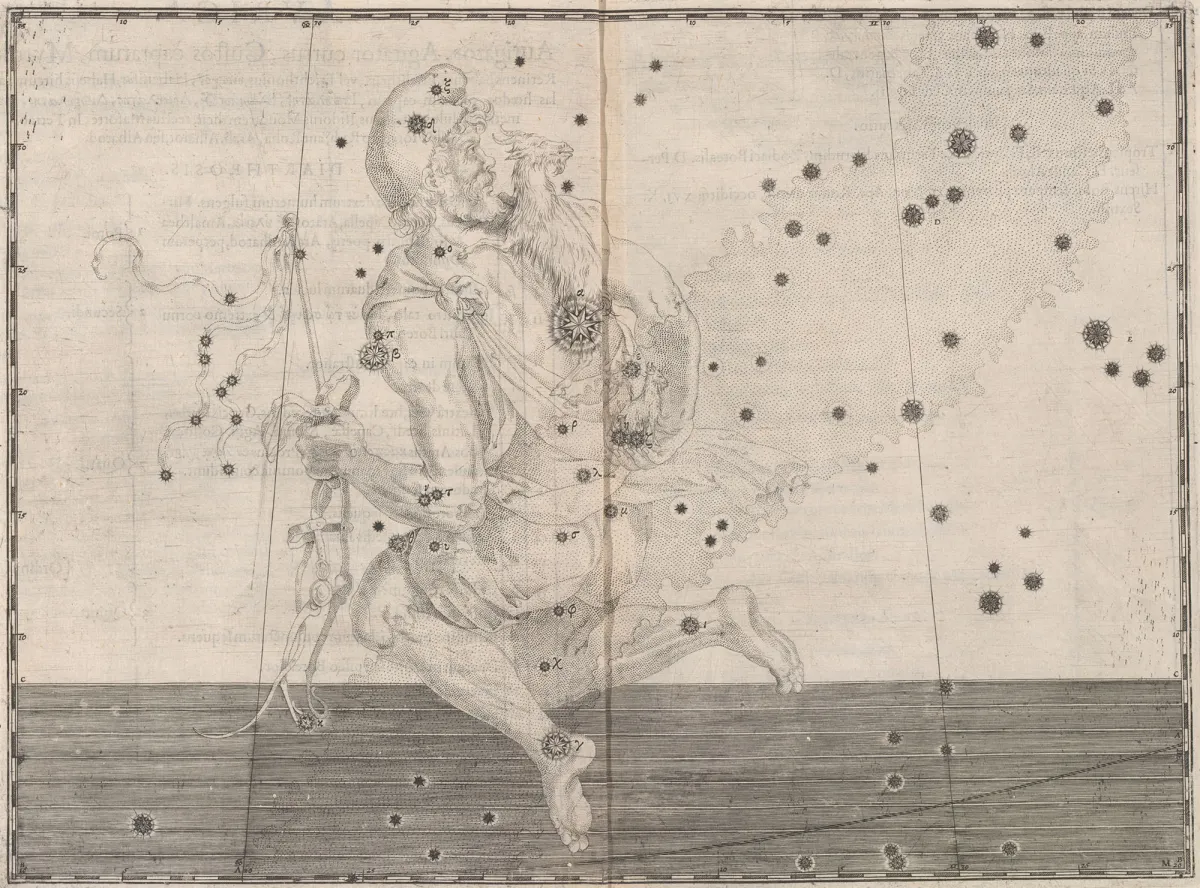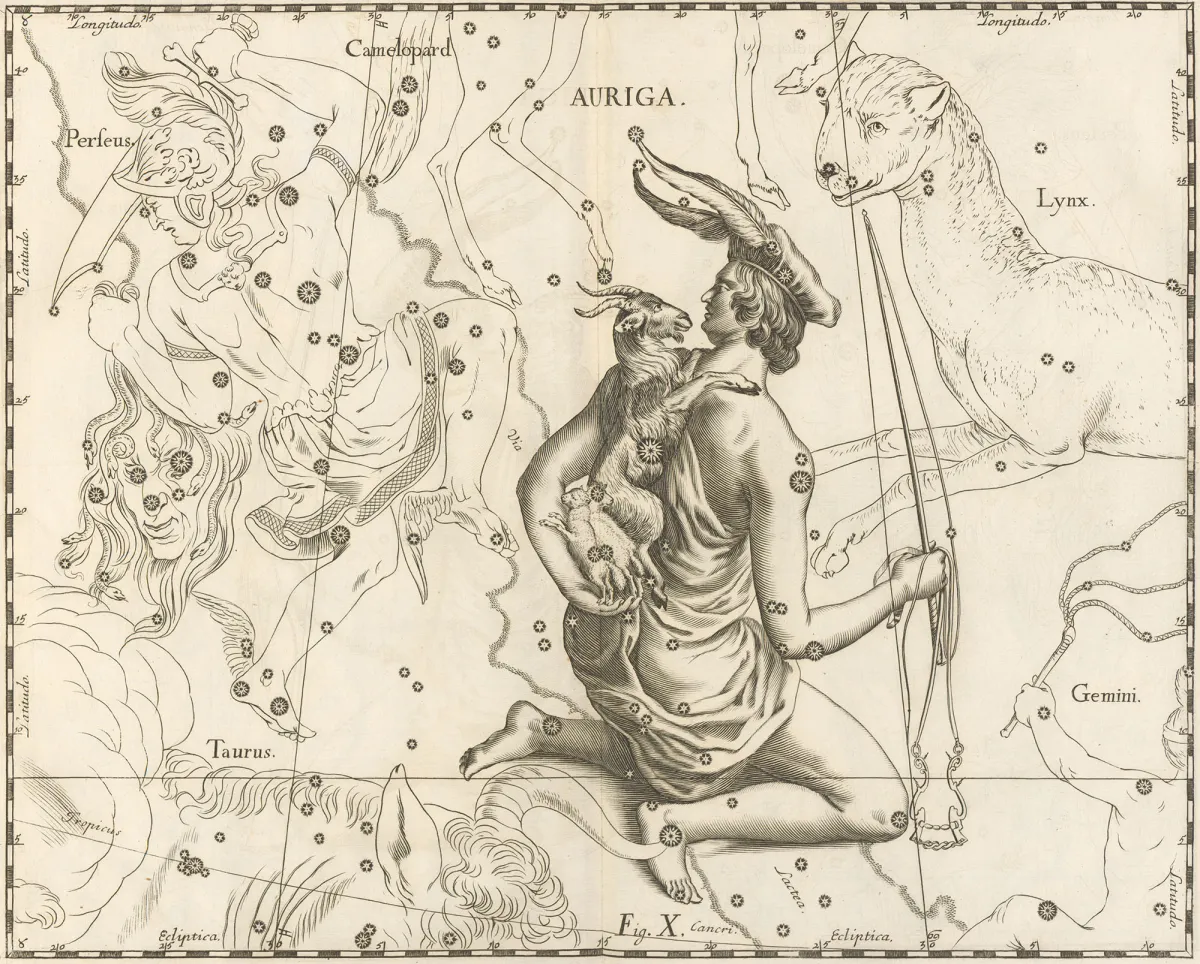Constellation Auriga (Charioteer)

Properties
Auriga is a striking constellation north of Taurus and Gemini and is roughly the shape of a pentagon. This formation shares a star with Taurus: γ Aurigae is also the northern horn of the bull and is recorded as β Tauri, El Nath (the horn). In most atlases one finds this star belonging to Taurus. A few degrees southwest of Capella is a small, pointed triangle, the tip of which points to the north. This formation is known as The Goatling which the Charioteer carries in his arms and is formed by ε, η, and θ Aurigae. [85]
The star Capella forms together with Aldebaran (α Tauri), Rigel (β Orionis), Sirius (α Canis Maior), Procyon (α Canis Minoris) and the two twin stars Castor and Pollux (α and β Geminorum) the winter hexagon. The area of the constellation Auriga is 657 square degrees and the centre culminates around midnight on December 9th. [9, 15]
| α Aur | Capella, Alhajoth |
| β Aur | Menkalinan, Menkalina |
| ε Aur | Al Anz, Almaaz |
| ζ Aur | Haedi, Haedus, Hoedus I |
| η Aur | Hoedus II |
| ι Aur | Hassaleh |
| IAU Name | Auriga |
| IAU Genitive | Aurigae |
| IAU Abbr. | Aur |
| English Name | Charioteer |
| Culmination at local midnight | 21 December |
| Season (Latitude +0.0°) | August … May |
| Right Ascension (J2000.0) | 04h 37m 54s … 07h 30m 56s |
| Declination (J2000.0) | +27° 53' 29" … +56° 09' 53" |
| Area | 657 deg2 |
| Neighbours (N↻) | Cam, Per, Tau, Gem, Lyn |
Deep-Sky Object Descriptions
Catalogues
Mythology and History
The constellation has been known as the Charioteer since Babylonian times. Two different images are superimposed, reminiscent of two different incidents: It depicts a carter carrying a goat with young billy goats on his shoulders.

The goat is reminiscent of Zeus' earliest youth: At the beginning of the earliest existence, when there was still chaos, an empty space, the origin of all things, the broad-chested earth emerged. She gave birth to Uranus, heaven, so that it would surround her and so that the gods might find a permanent home there one day. She even united with Uranus herself and gave birth to the Titans. Uranos wasn't exactly a loving father, because he hated his children, cast them into the gorges of the earth and was still happy about them. One of the titans, Kronos, who was also called the crooked-minded man, horrified himself on his father with a toothed sickle sword. Uranus lost his manhood and Kronos gained dominion in heaven. Such a deed could not go unpunished and so it was made known to him through a prophecy that his own son would conquer him and deprive him of rule. Kronos, worried about his future, killed and devoured all of his newborn sons.
The nymph Amaltheia, who lived in springs and waters, was well known on the Cretan Ida. She was able to secretly take one of the children away and hid it from his cruel father in the woods. She baptized the child in the name of Zeus. Amaltheia owned a beautiful goat, the mother of two goats. This goat stood out among the dictaean herds because it had high horns bent towards its back and an udder like the one Zeus' nurse had to have. She gave her milk to God; but then she broke off a horn on a tree and was deprived of half of its ornament. The nymph took the horn, wreathed it with fresh green, filled it with fruit and raised it to Zeus' face. When he was in control of heaven, sitting on his father's throne and nothing was stronger than the undefeated Zeus, he turned his wet nurse and the cornucopia, which still bears the name of his mistress, into stars. The brightly shining capella is this goat star and underneath there are two slightly smaller stars in which you can see the goats. [20]
The charioteer was not a coachman, but rather a leader of a racing car or perhaps a chariot who drove a team of four. Some say it meant Phaethon, who borrowed the sun chariot from his father, the sun god, and in his youthful arrogance almost set the whole earth and also the sky on fire. The traces of fire can still be seen today as a band of the Milky Way and you can see how far the sun car had strayed from its path back then. [20]

In addition to Phaethon, one also believes to see another charioteer in the carter, namely Erichthonius, the son of Hephaestus who was conceived without a mother. Hephaestus was the god of fire and the artful craftsmanship, was the limping son of Zeus and Hera. Athena once came to him, the virgin goddess of war, science and the arts. Hephaestus fell in love with her and tried to rape Athena, who was fighting with all his might. His seed flowed on the earth and the virgin Athena stepped on it with shameful anger. So the goddess of the earth received him and finally gave birth to the boy Erichthonius, whom she later handed over to Athena. This boy had snake feet. Athena raised the child by keeping it in a chest guarded by snakes. He grew up to be a man and became king. Erichthonius invented a chariot because he was ashamed to show his feet. The chariot was almost similar to the sun chariot, and Zeus was so impressed by this invention that he took Erichthonius to the sky as a furman and charioteer. [20, 85]
The Roman astronomical poet Hyginus saw another person in this star of the carter: Myrtilus or Myrtilos. The king of Oinomaos of Pisa had three sons and a daughter named Hippodameia with his wife Sterope. He owned a famous stud farm and was an invincible driver of horse racing cars. King Oinomaos was warned by an oracle that his son-in-law would kill him and so he tried to prevent Hippodameia's marriage. Every young man who tried to get Hippodameia had to go through a chariot race with their father. However, should he be overtaken by the king, he would have to die by the king's spear; so it was agreed. Twelve princes had already been killed and their severed heads adorned the palace gates. Pelops, the son of the Lydian king Tantalus, also wanted to free Hippodameia and asked Poseiden, the Greek god of the seas, the fastest chariot in the world, which could also race over sea waves. Arrived in front of the palace gate and given the gruesome framing of the driveway, his courage failed. So he made use of a ruse: he promised Myrtilus - that was the king's charioteer, who was himself in love with the beautiful Hippodameia - half of his future kingdom and the right to sleep with Hippodameia on their wedding night, if he could in some way Successfully hamper the king's racing car. Myrtilos, inspired by sweet thoughts, secretly removed the pins from the axles of the wheels and replaced them with wax replicas. What happened next is easy to imagine: The king's racing car lost its wheels at full speed and the king was killed in the process. When Myrtilos wanted to claim his right to the wedding night, Pelops pushed him into the sea, where he drowned. Hermes, he was the father of Myrtilus, could not prevent this crime in time; he therefore placed him among the stars as the constellation of the charioteer. [20]
The original Greek name of this constellation was Heniochus (The One Who Holds the Reins). Other names for this constellation were Phaethon, Bellerophon, but also Custos caprarum, i.e. the goat keeper. What is meant is the goat that Zeus once served as a wet nurse. [20]